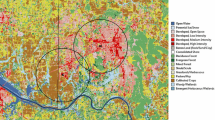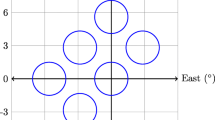Abstract
The high-power Defford radar has been upgraded to provide Doppler information regarding the motion of echoes from weak refractive index inhomogeneities within the optically clear atmosphere. A case study is presented in which data from the radar are used to derive the detailed velocity structure in and above the planetary boundary layer. These data are analysed to show how convective circulations in the boundary layer can perturb the height of a shallow inversion overlying it, thereby producing local enhancements of wind shear and a decrease in dynamic stability within the inversion. The measurements were obtained as part of a Boundary-Layer Project in which simultaneous measurements were made using fast-response instruments suspended from a tethered balloon within the region scanned by the radar. The balloon-borne probes showed that the most intense turbulence and fluctuations of temperature and refractivity were encountered when radar-detected hummocks in the height of the inversion were advected through the probes. The fine-scale turbulence measurements within the perturbed inversion are consistent with the existence of Kelvin-Helmholtz billows.
Similar content being viewed by others
References
Atlas, D., Hardy, K. R., and Naito, K.: 1966, ‘Optimizing the Radar Detection of Clear Air Turbulence’,J. Appl. Meteorol. 5, 450–60.
Atlas, D., Metcalf, J. I., Richter, J. H., and Gossard, E. E.: 1970, ‘The Birth of “CAT” and MicroScale Turbulence’,J. Atmos. Sci. 27, 903–13.
Browning, K. A.: 1972, ‘Atmospheric Research Using the Defford Radar Facility’,Weather 27, 2–13.
Browning, K. A., Starr, J. R., and Whyman, A. J.: 1972, ‘Measurements of Air Motion in Regions of Clear Air Turbulence Using High-Power Doppler Radar’,Nature 239, 267–69.
Dutton, J. A. and Lane, J. A.: 1969, ‘Intermittency of Small-Scale Structure’,Radio Sci. 4, 1357–59.
Golton, E., Champion, R. B. J., and Harris, G.: 1972 (to be published).
Gossard, E. E. and Munk, W.: 1954, ‘On Gravity Waves in the Atmosphere’,J. Meteorol. 11, 259–69.
Kaimal, J. C. and Businger, J. A.: 1970, ‘Case Studies of a Convective Plume and a Dust Devil’,J. Appl. Meteorol. 9, 612–20.
Lane, J. A.: 1968, ‘Small-Scale Variations of Refractive Index in, the Troposphere’,Proc. IEE 115, 1227–34.
Lane, J. A.: 1969, ‘Some Aspects of the Fine Structure of Elevated Layers in the Troposphere’,Radio Sci. 4, 1111–14.
Readings, C. J. and Butler, H. E.: 1972 (To be published).
Readings, C. J., Golton, E., and Browning, K. A.: 1973, ‘Fine-Scale Structure and Mixing Within an Inversion’, this issue, p. 275.
Rogers, R. R.: 1957, ‘Radar Measurements of Gustiness’, inProc. 6th Weather Radar Conference, Am. Meteorol. Soc., Boston, pp. 99–106.
Scorer, R. S.: 1969, ‘Mechanisms of Clear Air Turbulence’, in Y.-H. Pao and A. Goldburg (eds.),Clear Air Turbulence, Plenum Press, New York. pp. 34–49.
Townsend, A. A., 1966, ‘Internal Waves Produced by a Convective Layer’,J. Fluid Mech. 24, 307–19.
Watkins, C. D.: 1971, ‘High Power Radar for Meteorological Studies in Clear Air’,Proc. IEE 118, 519–27.
Author information
Authors and Affiliations
Rights and permissions
About this article
Cite this article
Browning, K.A., Starr, J.R. & Whyman, A.J. The structure of an inversion above a convective boundary layer as observed using high-power pulsed doppler radar. Boundary-Layer Meteorol 4, 91–111 (1973). https://doi.org/10.1007/BF02265226
Received:
Issue Date:
DOI: https://doi.org/10.1007/BF02265226




